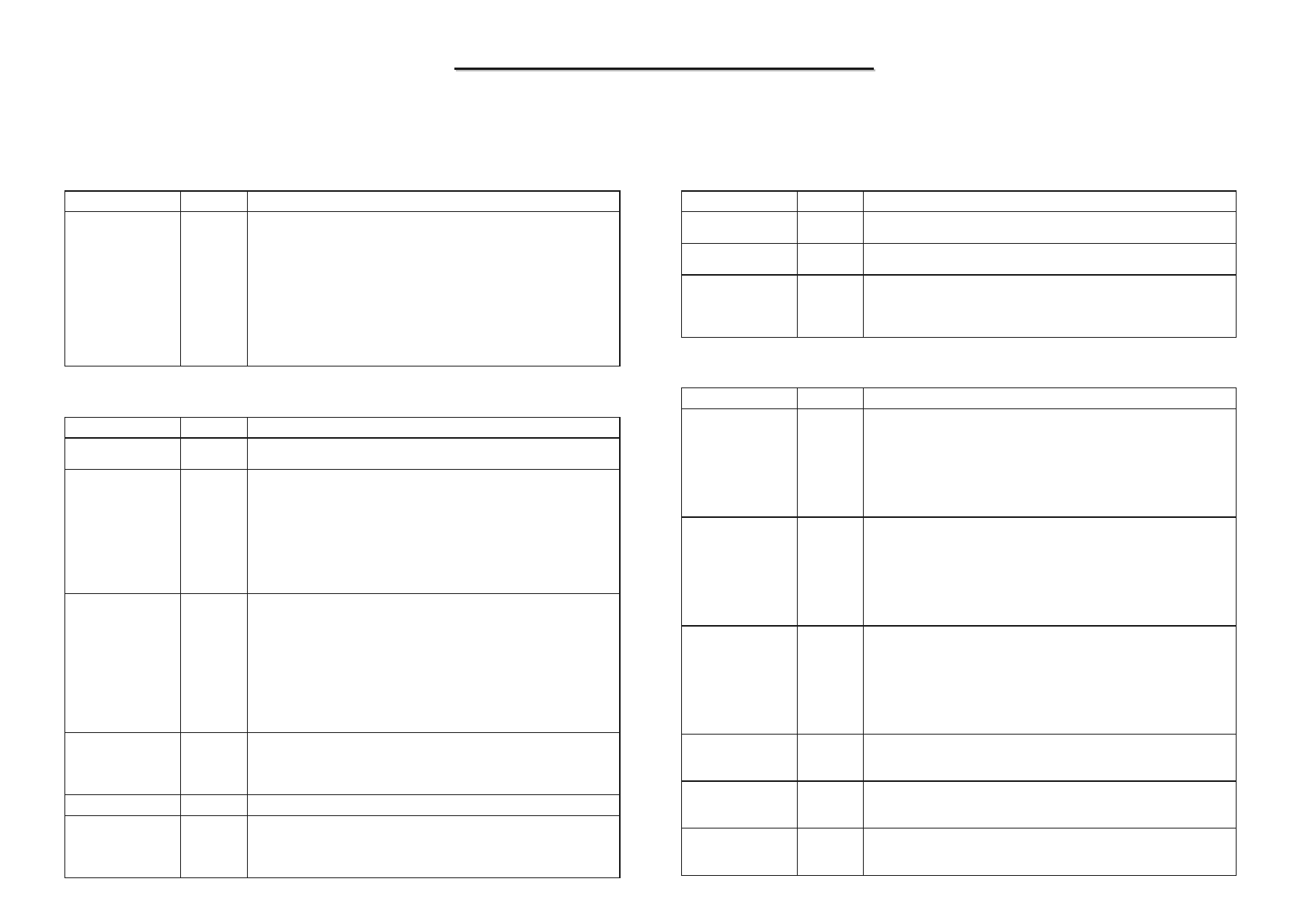
8050
8050
D N/B Maintenance
D N/B Maintenance
87
IDE Interface Signals (Continued)
Signal Name Type Description
PIORDY#/
(PDRSTB/PWDMA
RDY#)
SIORDY#/
(SDRSTB/SWDMA
RDY#)
I Primary and Secondary I/O Channel Ready (PIO): This signal
will keep the strobe active (PDIOR# or SDIOR# on reads, PDIOW#
or SDIOW# on writes) longer than the minimum width. It adds wait
states to PIO transfers.
Primary and Secondary Disk Read Strobe (Ultra DMA Reads from
Disk): When reading from disk, the ICH4 latches data on rising and
falling edges of this signal from the disk.
Primary and Secondary Disk DMA Ready (Ultra DMA Writes to
Disk): When writing to disk, this is de-asserted by the disk to pause
burst data transfers.
Interrupt Signals
Signal Name Type Description
SERIRQ
I/O Serial Interrupt Request: This pin implements the serial interrupt
protocol.
PIRQ[D:A]#
I/OD PCI Interrupt Requests: In Non-APIC Mode the PIRQx# signals
can be routed to interrupts 3, 4, 5, 6, 7, 9, 10, 11, 12, 14 or 15 as
described in the Interrupt Steering section. Each PIRQx# line has a
separate Route Control Register.
In APIC mode, these signals are connected to the internal I/O APIC
in the following fashion: PIRQ[A]# is connected to IRQ16,
PIRQ[B]# to IRQ17, PIRQ[C]# to IRQ18, and PIRQ[D]# to IRQ19.
This frees the legacy interrupts.
PIRQ[H:E]#/
GPIO[5:2]
I/OD PCI Interrupt Requests: In Non-APIC Mode the PIRQx# signals
can be routed to interrupts 3, 4, 5, 6, 7, 9, 10, 11, 12, 14 or 15 as
described in the Interrupt Steering section. Each PIRQx# line has a
separate Route Control Register.
In APIC mode, these signals are connected to the internal I/O APIC
in the following fashion: PIRQ[E]# is connected to IRQ20,
PIRQ[F]# to IRQ21, PIRQ[G]# to IRQ22, and PIRQ[H]# to IRQ23.
This frees the legacy interrupts. If not needed for interrupts, these
signals can be used as GPIO.
IRQ[14:15]
I Interrupt Request 14:15: These interrupt inputs are connected to
the IDE drives. IRQ14 is used by the drives connected to the
Primary controller and IRQ15 is used by the drives connected to the
Secondary controller.
APICCLK
I APIC Clock: This clock operates up to 33.33 MHz.
APICD[1:0]
I/OD APIC Data: These bi-directional open drain signals are used to
send and receive data over the APIC bus. As inputs the data is valid
on the rising edge of APICCLK. As outputs, new data is driven
from the rising edge of the APICCLK.
LPC Interface Signals
Signal Name Type Description
LAD[3:0]/
FWH[3:0]
I/O LPC Multiplexed Command, Address, Data: For the LAD[3:0]
signals, internal pull-ups are provided.
LFRAME#/
FWH[4]
O LPC Frame: LFRAME# indicates the start of an LPC cycle, or an
abort.
LDRQ[1:0]#
I LPC Serial DMA/Master Request Inputs: LDRQ[1:0]# are used
to request DMA or bus master access. These signals are typically
connected to an external Super I/O device. An internal pull-up
resistor is provided on these signals.
USB Interface Signals
Signal Name Type Description
USBP0P,
USBP0N,
USBP1P,
USBP1N
I/O Universal Serial Bus Port 1:0 Differential: These differential
pairs are used to transmit data/address/command signals for ports 0
and 1. These ports can be routed to USB UHCI Controller #1 or the
USB EHCI Controller.
NOTE: No external resistors are required on these signals. The
ICH4 integrates 15 k . pull-downs and provides an output driver
impedance of 45 . which requires no external series resistor
USBP2P,
USBP2N,
USBP3P,
USBP3N
I/O Universal Serial Bus Port 3:2 Differential: These differential
pairs are used to transmit data/address/command signals for ports 2
and 3. These ports can be routed to USB UHCI Controller #2 or the
USB EHCI Controller.
NOTE: No external resistors are required on these signals. The
ICH4 integrates 15 k . pull-downs and provides an output driver
impedance of 45 . which requires no external series resistor.
USBP4P,
USBP4N,
USBP5P,
USBP4N
I/O Universal Serial Bus Port 5:4 Differential: These differential
pairs are used to transmit data/address/command signals for ports 4
and 5. These ports can be routed to USB UHCI Controller #3 or the
USB EHCI Controller
NOTE: No external resistors are required on these signals. The
ICH4 integrates 15 k . pull-downs and provides an output driver
impedance of 45 . which requires no external series resistor
OC[5:0]#
I/O Overcurrent Indicators: These signals set corresponding bits in
the USB controllers to indicate that an overcurrent condition has
occurred.
USBRBIAS
O USB Resistor Bias: Analog connection point for an external
resistor to ground. USBRBIAS should be connected to
USBRBIAS# as close to the resistor as possible.
USBRBIAS#
I USB Resistor Bias Complement: Analog connection point for an
external resistor to ground. USBRBIAS# should be connected to
USBRBIAS as close to the resistor as possible.
5.3 Intel 82801DBM I/O Controller Hub 4 Mobile (ICH4-M)(4)
MiTac Secret
Confidential Document


















